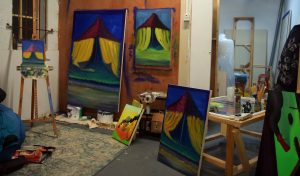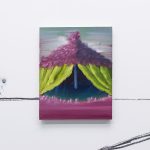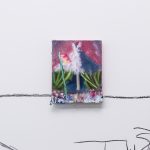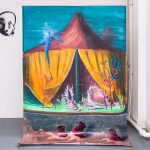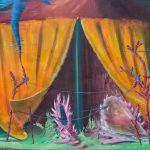Narrazioni altre #2
Una tenda può sempre essere molto più di una tenda
con Parham Ghalamdar
ITA (English below)
Parham Ghalamdar (1994) è un pittore professionista, nasce a Tehran, Iran, e attualmente vive e lavora a Manchester.
Ci sono tre tele appese ai muri del suo studio, in tutte appare la stessa tenda, che poi stessa non è. Ghalamdar mi dice che è durante il lockdown che inizia a dipingere questo soggetto, in maniera quasi ossessiva, osservando che unə pittorə non ha bisogno di molti soggetti diversi, può sceglierne uno e riprodurlo a ripetizione, ché tanto non si ripeterà mai.
Nonostante le tende di Ghalamdar siano di colori che tendono al violetto e ricoperte di piume, appaiono in un certo senso antiche e tolte al loro tempo. L’artista, infatti, mi mostra dal primo libro di una pila di libri, l’immagine dell’affresco Il sogno di Costantino realizzato da Piero della Francesca nella Cappella Bacci della Basilica di San Francesco ad Arezzo come parte del ciclo di affreschi Storie della Vera Croce e databile tra il 1452 e il 1466.
Philippe Guston in un testo dedicato alla pratica del maestro rinascimentale, afferma che nella pittura di Piero della Francesca persiste una certa ansia, dicendo che ciò che vediamo è la meraviglia di ciò che viene visto. Forse è l’ansia della pittura stessa. Il piano dell’immagine nei dipinti di Piero della Francesca sono paragonabili a delle illusioni, a dei luoghi dove le forme del luogo sono messe in pausa. È proprio questa dimensione di messa in pausa, la quale apre all’idea di un possibile “continua…”, che interessa a Ghalamdar.
L’artista, la cui pratica è influenzata da il mondo cinematografico in particolare dall’area Sci-fi, immagina l’affresco de Il sogno di Costantino come un fotogramma isolato da uno storyboard molto più grande. Chi osserva si trova essə stessə nello spazio-tempo sospeso del fotogramma, e può dunque immaginare le scene precedenti e successive. Questo è ciò che sembra accadere nelle tele di Parham Ghalamdar, le sue tende narrano il continuo della storia iniziata ne Il Sogno di Costantino, una storia che evolve e si ripete, mai uguale a sé stessa.
Osservando le tre tende, che si costruiscono tutte attorno a una composizione simile e alla stessa palette di colori, si può notare che le piume che ricoprono la parte superiore sono un po’ diverse tra loro.
La spiegazione di questa leggera differenza quasi impercettibile ad un occhio non attento potrebbe trovarsi nell’influenza che l’Intelligenza Artificiale, in particolare i sistemi E-GAN (Evolutionary Generative Adversarial Networks)[1], ha sulla ricerca di Ghalamdar. Se l’E-GAN viene alimentato con immagini e dipinti, questo trova i patterns e sviluppa nuove, e potenzialmente infinite, versioni di questi variando leggermente lo stile. Citando le parole dello stesso artista “Questo sistema mi ricorda la modalità sandbox nella pittura, il fatto che un quadro non è mai finito. Si può sempre dipingere oltre, più e più volte, ed esaurire un dipinto.”
L’artista trova dei punti in comune tra l’Intelligenza Artificiale e la pittura, affermando che entrambe non sono altre che tentativi di ordinare la realtà. Riordinare un mondo in cui l’assurdo è uno stato esistenziale, cercare un significato nel non-senso porta inevitabilmente a un conflitto, questo è lo spazio in cui Ghalamdar dice avvengano i suoi dipinti. Dipingere diventa quindi un co-operare con la vita, e l’unica via possibile per dialogare con l’assurdo è abbracciarlo e perseguirlo, adottarlo come metodo. Così nelle opere di Parham Ghalamdar si vedono mondi lontani, unirsi in un linguaggio eterogeneo che unisce tempi, culture e luoghi, espandendo il concetto di pittura in sé.
Nelle sue opere si riconoscono vari riferimenti da cartoni animati 2D e film Sci-Fi come Alien di Ridley Scott, a dipinti dei maestri del passato e locandine iraniane di film hollywoodiani. L’universo che si crea è volutamente anti-narrativo, infatti l’assurdo spoglia gli elementi dalla loro carica narrativa per favorire la pittura nello sviluppo di una sua propria identità.
Parham Gahlamdar con la sua pratica cerca di ampliare gli orizzonti della pittura, utilizzando metodi che permettono di esplorare orizzonti impensati o impensabili. Forse per questo i suoi dipinti sembrano in movimento e pare di assistere alla loro evoluzione, tanto che distogliendo lo sguardo dal dipinto e poi tornando a questo, si trova qualcosa che prima non si aveva notato. Ghalamdar sposta continuamente l’arrivo un po’ più in là, lasciando lə altrə e sé stesso in attesa, in pausa come la tenda di Piero della Francesca; come se stesse lavorando a un dipinto infinito, in eterna generazione.
Prendendo ancora una volta in prestito le parole di Guston, si potrebbe dire che di fronte alle tele di Parham Gahlamdar siamo sospesə tra l’ordine che vediamo e l’apprensione che tutto possa di nuovo muoversi, eppure non è così. È un punto estremo dell’impossibilità della pittura. O della sua possibilità. La sua frustrazione. La sua continuità.
[1] Nel campo dell’apprendimento automatico, si definisce rete generativa avversaria o rete antagonista generativa o rete contraddittoria generativa, o in inglese generative adversarial network (GAN), una classe di metodi, introdotta per la prima volta da Ian Goodfellow, in cui due reti neurali vengono addestrate in maniera competitiva all’interno di un framework di gioco minimax. Questo tipo di framework permette alla rete neurale di apprendere come generare nuovi dati aventi la stessa distribuzione dei dati usati in fase di addestramento. Ad esempio, è possibile ottenere una rete neurale in grado di generare volti umani iperrealistici.
* * *
Other narratives #2
A tent can always be much more than a tent
with Parham Ghalamdar
(ENG)
Parham Ghalamdar (1994) is a professional painter, born in Tehran, Iran, and currently living and working in Manchester.
There are three canvases hanging on the walls of his studio, in all of them the same, which is never the same, tent appears. Ghalamdar tells me that it was during the lockdown that he began to paint this subject, almost obsessively, observing that a painter does not need many different subjects, they can choose one and reproduce it over and over again, because it will never be the same.
Although Ghalamdar’s tents are tending toward purple and are covered with feathers, they appear in a sense ancient and removed from their time. The artist, in fact, shows me from the first book of a stack of books, the image of the fresco Constantine’s Dream painted by Piero della Francesca in the Bacci Chapel of the Basilica of San Francesco in Arezzo as part of the fresco cycle The Legend of the True Cross and datable between 1452 and 1466.
Philippe Guston, in a text dedicated to the Renaissance master’s practice, states that certain anxiety persists in Piero della Francesca’s painting, saying that what we see is the wonder of what is seen. Perhaps it is the anxiety of painting itself. The plane of the image in Piero della Francesca’s paintings is comparable to illusions, to places where the forms of place are put on pause. It is precisely this dimension of pause, which opens up the idea of a possible “to be continued…”, that interests Ghalamdar.
Ghalamdar, whose practice is influenced by the cinematic world, particularly Sci-fi movies, imagines the fresco of Constantine’s Dream as an isolated frame from a much larger storyboard. The viewer finds themselves in the suspended space-time of the frame, and can therefore imagine the preceding and following scenes. This is what seems to happen in Parham Ghalamdar’s canvases; his tents tell the continuum of the story begun in Constantine’s Dream, a story that evolves and repeats itself, never the same.
Looking at the three tents, which are all built around a similar composition and the same colour palette, one can see that the feathers that cover the top of one tent, are a little different from the feathers that cover the top of the others.
The explanation for this slight difference, almost imperceptible to the untrained eye, may lie in the influence that Artificial Intelligence (AI), in particular E-GAN (Evolutionary Generative Adversarial Networks)[1] systems, have on Ghalamdar’s research. If E-GAN is fed with images and paintings, it finds the patterns and develops new, and potentially infinite, versions of them by varying the style slightly. Quoting the artist’s own words, “This system reminds me of the sandbox mode in painting, the fact that a painting is never finished. You can always paint further, over and over, and exhaust a painting.”
The artist finds commonalities between AI and painting, stating that both are nothing more than human attempts to order reality. Rearranging a world in which the absurd is an existential state, seeking meaning in the non-sense inevitably leads to conflict, this is the space in which Ghalamdar says his paintings take place. Painting then becomes a co-operation with life, and the only possible way to dialogue with the absurd is to embrace and pursue it, to adopt it as a method. Thus in Parham Ghalamdar’s works, we see distant worlds come together in a heterogeneous language that unites times, cultures, and places, expanding the concept of painting itself.
In his works, it is possible to recognise various references from 2D cartoons and Sci-Fi movies such as Ridley Scott’s Alien, to paintings by the masters of the past and Iranian Hollywood movie posters. The universe that is created is deliberately anti-narrative, in fact, the absurd strips the elements of their narrative to encourage the painting in the development of its own identity.
Parham Gahlamdar with his practice tries to expand the horizons of painting, using methods that allow him and the other to explore unthought or unthinkable horizons. Perhaps this is why his paintings seem to be in motion and it seems as if one is witnessing their evolution, so much so that looking away from the painting and then returning to it, one finds something that wasn’t noticed before. Ghalamdar continually moves the arrival a little further, leaving the other and himself waiting, paused like Piero della Francesca’s tent; as if he were working on an infinite painting, in eternal processing.
Borrowing Guston’s words once again, one could say that in front of Parham Gahlamdar’s canvases we are suspended between the order we see and the apprehension that everything can move again, yet this is not the case. It is an extreme point of the impossibility of painting. Or of its possibility. Its frustration. Its continuity.
[1] A generative adversarial network (GAN) is a class of machine learning frameworks designed by Ian Goodfellowand his colleagues in June 2014. Two neural networks contest with each other in a game (in the form of a zero-sum game, where one agent’s gain is another agent’s loss). Given a training set, this technique learns to generate new data with the same statistics as the training set. For example, a GAN trained on photographs can generate new photographs that look at least superficially authentic to human observers, having many realistic characteristics.


